
Station Name: HOOLE [Source:Tony Graham &
Paul Wright]
old5.jpg) Hoole station looking south-west in the early 1950s. Close observation shows that the notice boards were still headed LMS whilst the posters themselves carry the British Railways totem image. In this view Hoole looks every inch the typical English rural station.
Photo from John Mann collection and Stations UK  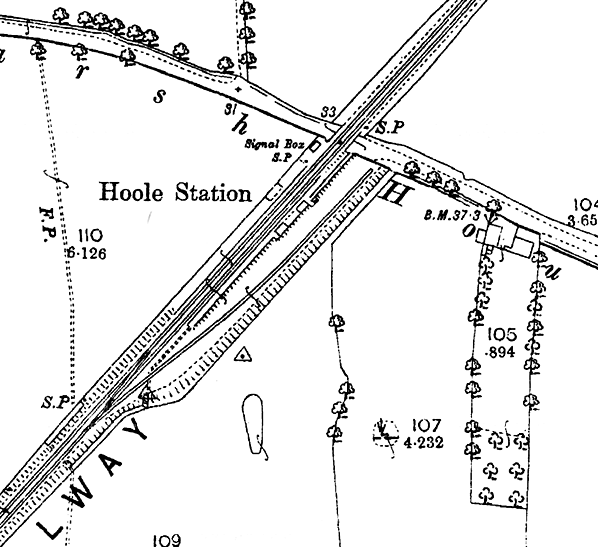 1893 1:2,500 OS map. As can be seen from the map the station had only very basic goods facilities. The map also illustrates its remote location.
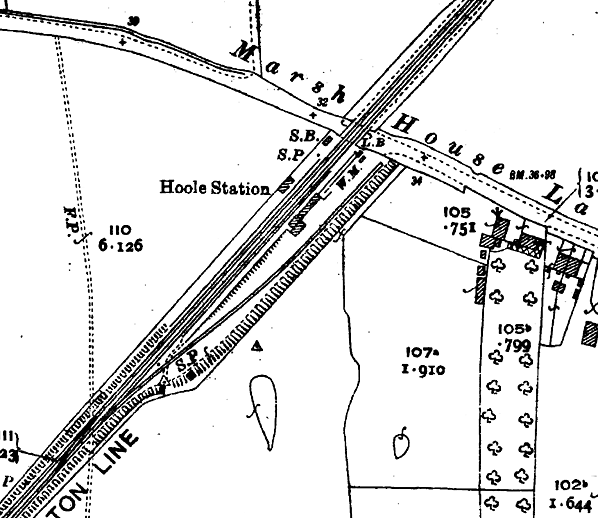 1931 1:2,500 OS map. Little had changed since the time of opening although there are
some additional buildings. old6.jpg) The waiting shelter on the ‘down’ (Preston-bound) platform at Hoole station in the early 1960s.
old7.jpg) Looking south-west at Hoole station from the level crossing in June 1963. There were still trucks present in the goods yard. The yard closed on 6 April 1964, five months before the line closed.
Photo from John Mann collection old4.jpg) Class 5MT locomotive No. 45078 is seen arriving at Hoole in August 1964. The locomotive is working a Preston to Southport Chapel Street train. The station facilities on the ‘up’ (towards Southport) platform can be seen to the right. Built for the LMS in March 1935 by the Vulcan Foundry, this Stanier Black Five entered service as 5078. With a working life of over 30 years, it was withdrawn in October 1965 and scrapped at Cashmores (Great Bridge) in December of that year.
Photo by D. Hampson old3.jpg) Looking north-east from the Preston end of Hoole station's down platform in August 1964. The approaching train is the 12:37 pm Saturdays-only Preston to Southport Chapel Street service. At the head of the train is Fairburn 4MT locomotive No. 42675. Hoole signal box - which controlled the crossing, access to the goods yard and the line through the station - can be seen to the left. Also of interest is the name board, seen to the right, which predates nationalisation.
Photo by D. Hampson old2.jpg)
Looking south-west towards Southport from Hoole station's down (Preston direction) platform in August 1964 as the same train (as above) prepares to depart for Southport Chapel Street. The station gardens appear well tended. 42675 was built by the LMS in 1945 at Derby Works. This Fairburn-designed 4P 2-6-4-tank was delivered new to 5D, Stoke shed. After allocations to 5F Uttoxeter, 9E Trafford Park and 8P Wigan Central (L&Y) it was allocated to 27C, Southport, from where it was withdrawn on 18.9.1965 and cut up at Wards in November of the same year.
Photo by D. Hampson
old1.jpg) The 12:40 pm Southport Chapel Street to Preston service is seen arriving at Hoole Station in August 1964. The picture shows the south-west end of the station. Beyond the platforms the points which controlled access to the station goods yard can be seen. At this time the goods yard was already out of use, having closed on 6 April. Built at Derby works in May, 1936, this Stanier 2-6-4T was first numbered 2445 by the LMS. Becoming 42445 at nationalisation, it was allocated to 1C, Watford Shed until January 1954 when it moved North to 9B, Stockport Edgeley. After allocations to five other sheds in the North West, it moved to 24C, lostock Hall in June 1963 from where it was withdrawn on 17.10.1964, a few months after this picture was taken. The loco was scrapped in March, 1965 by Wards of Beighton and none of these are preserved.
Photo by D. Hampson old8.jpg) This is a very rare visitor to the line, 'Jubilee' 3-cylinder 4-6-0 No. 45642 'Boscawen' is photographed leaving the lonely windswept outpost of the South Lancashire mosslands at Hoole on Saturday 5 September 1964 at the head of the 12.44 pm Southport - Preston stopper. The last train ran the following day. 45642 was built at Crewe in May 1934 and is seen hauling three coaches, a very light load for this loco. It had a working life of over 30 years, being withdrawn on 9.1.1965 and cut up in May of the same year. Even in the closing years of the West Lancs line, apart from the Crossens electrics, all goods and passenger services remained steam-hauled. Augmented by the once numerous inter-regional excursions, observers continued to be treated to an interesting and varied selection of motive power on this line.
Photo by Alan Castle 1.jpg) Looking north-east at the site of Hoole station through the level crossing gates in May 1968. Sections of rail are embedded in the road. The moody sky enhances a scene of desolation at what had only four years earlier been a
busy railway line. Photo by Tony Graham 1.jpg) Hoole station looking north-east towards the level crossing (which is seen in the background) in October 1989. To the right are the degraded remains of the up platform.
Photo by Nick Catford 9.jpg) Hoole station, looking north-east in July 2011. The mounds to the left and right are degraded remains of the platforms. Despite being overgrown the layout of the former station is clearly demarcated by the vegetation: the trackbed is occupied by lusher green vegetation which includes Rosebay Willow Herb (with the pink flowers) whilst the platforms support coarser grass species. This variation reflects the different properties of the soils on the trackbed and on the platforms.
Photo by Paul Wright 12.jpg) Hoole station looking south-west from the level crossing in November 2011. The platforms are little more than degraded mounds now.
Photo by Carl Sanderson  Home
Page Home
Page
|
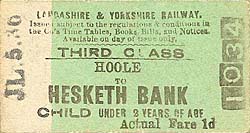
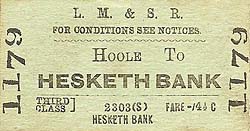

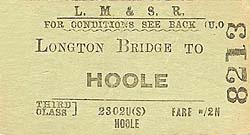
.gif)
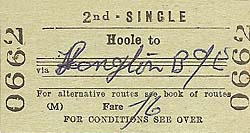
6.jpg)